I stopped my car along Rte. 101 this evening, as I was driving from Dublin to Brattleboro, to take this photo of the sun starting to set on Brewster Forest. This is, by far and away, the best time of year to visit New England, and, by my count, the 12th year since 2000 that I have done so.

When Fall comes to New England
And the wind blows off the sea
Swallows fly in a perfect sky
And the world was meant to be
When the acorns line the walkways
Then winter can’t be far
From yellow leaves a blue jay calls
Grandmothers walk out in their shawls
And chipmunks run the old stone walls
When Fall comes to New England
— Cheryl Wheeler, When Fall Comes to New England
Rosie Le Faive writes, in The Past is a Foreign Country:
But what happened in the past has lasting consequences. It can’t just “stay in the past.” If the consequences haven’t been apparent to you, that’s the problem. To say it “was okay at the time” is missing the point. It was not okay then, but you were able to ignore anyone who said it wasn’t.
After cycling to the airport, flying to Montreal, and making my way by public transit to my brother’s house, I was ready for the final leg of my journey from Charlottetown to southern New Hampshire.
In 2013 I made the journey by bus, train, and rental car; this time I set out to drive a battery-electric vehicle.
While traveling by EV isn’t “no emissions” travel–the cars need to be manufactured, and something needs to generate the electricity that powers them–doing my charging in Quebec and Vermont for most of my trip, both of which generate more than 95% of their electricity from non-fossil sources, means that an EV is, relative to almost any other means of travel, light on the land. It doesn’t hurt that my client Yankee Publishing has a 93 kW solar array generating a good portion of the electricity that I can plug into while at the office.
It’s not easy to rent an electric vehicle: while you can find them on Turo from private owners, they tend to be expensive (mostly, it seems, Tesla owners paying off their steep car loans). Fortunately, in Montreal, Discount rents Chevy Bolt EVs at very attractive rates: on my last trip to New Hampshire I rented a gas-powered car for 6 days from Hertz for $340; to rent an electric Bolt from Discount for 8 days was $411.
Here’s the play-by-play of how it’s gone so far.
Saturday, 2:00 p.m.
I arrived at the Discount office on Papineau to pick up the car. There was some confusion about the rental terms–I had an email confirming I’d be entitled to 300 km/day; they initially claimed it was 100 km–but we worked it out in my favour. And it turned out that the Bolt they had ready for me was only half-charged, meaning my first task before setting off the next morning on a long distance drive would be to charge it. Otherwise, though, it all went easily, and, after a brief “here’s where you plug it in” tutorial, my brother and I drove off for coffee and groceries and then to find a charging station.
Saturday, 3:52 p.m.
Relative to Prince Edward Island, Montreal has mind-boggling EV charging options: it turned out that there was a Electric Circuit on-street charger just blocks from my brother’s house, and it was free when we drove by, so I parked the car, quickly set up an account with the Electric Circuit Android app, and a few minutes later I was off and charging.
I got an email and text notification when the charge was done, four and a half hours later. The total cost of the charge, with tax, was $4.48 and consumed 28.6 kWh, about what our house uses in 2 days.
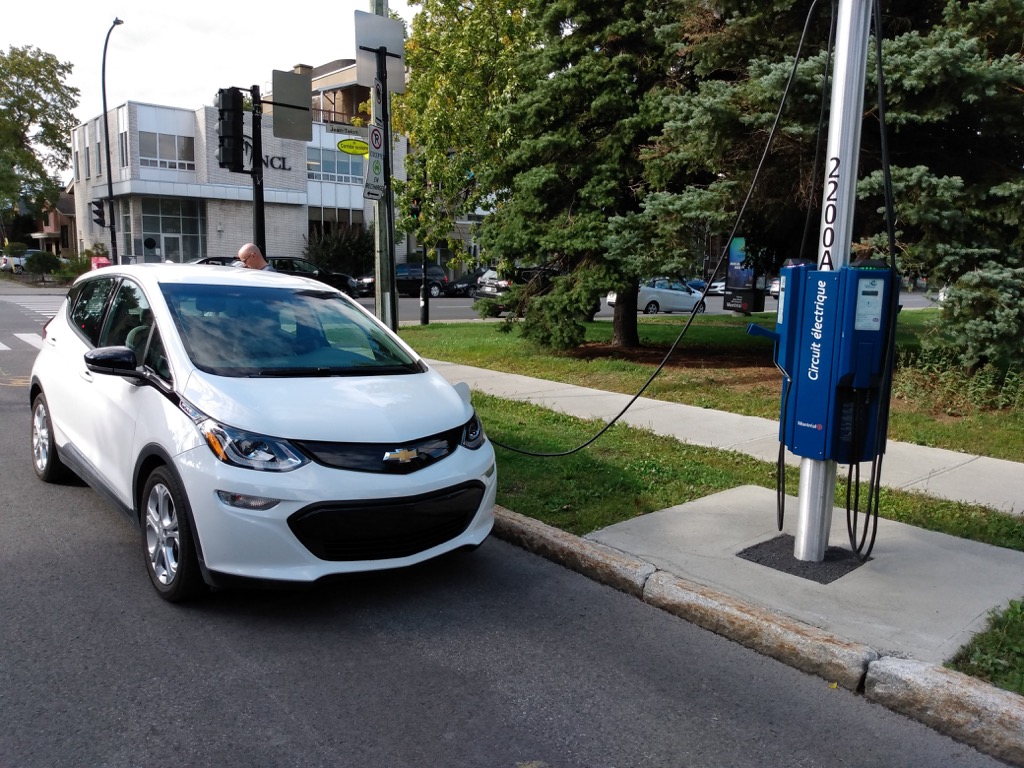
Sunday, 10:00 a.m.
After breakfast with my sister-and-law and my nephews, and some last minute Berenstain Bears-reading action, I headed off on my journey to New Hampshire. It was a beautiful day for driving, and I made good time, arriving at the U.S. border at 11:25 a.m. The line at the border took about 20 minutes to get to the head of; customs formalities took about 20 seconds (where do you live? where are you heading?). And then I was on the Interstate 89 heading into northern Vermont.
Sunday, 1:13 p.m.
About 200 km into the journey, I decided to stop in Waterbury, Vermont for a charge. I wasn’t in dire need of one, by any means, but I needed a break, and I was eager to see as many different charging arrangements as possible.
I followed the road signs pointing to EV charging at the Visitor Centre, and found a ChargePoint station there. It was charging a Nissan Leaf at the time, though, so I headed back out on the highway and up the hill to the Ben & Jerry’s, which promised a whole host of stations. And there were a whole host of stations: a high-speed CHAdeMO DC charger (not compatible with my Bolt) and six level 2 chargers, two from Sema Connect and four from AeroVironment.
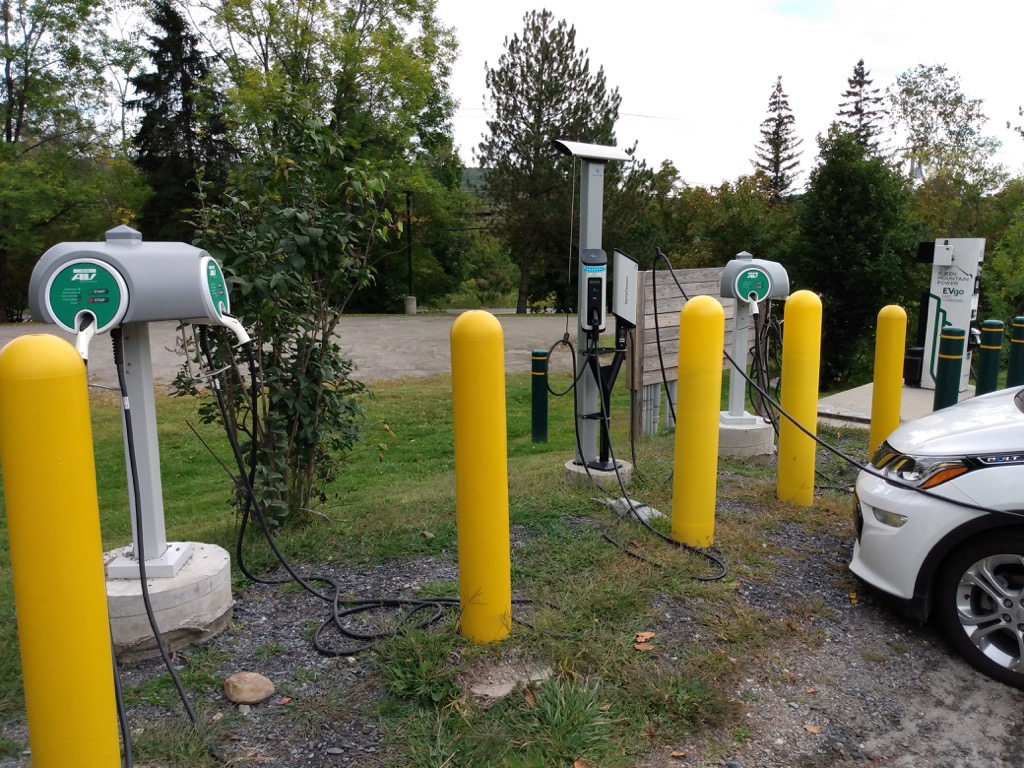
I tried in vain to get the Sema Connect app on my phone to authorize one of its chargers, but it kept failing, so I tried one the AeroVironment chargers and found, despite no signage to this effect, that it was free. I left the car charging and took a quick walk around the grounds and, finding them generally tired and depressing, decided to decamp down the road to a putative high speed charger at a Chevy dealer in Montpelier for a full top-up.
Sunday, 2:40 p.m.
I found my way to Cody Chevrolet in Montpelier using Google Maps and found that the dealership courtesy pick-up truck was parked in front of the high speed charger:
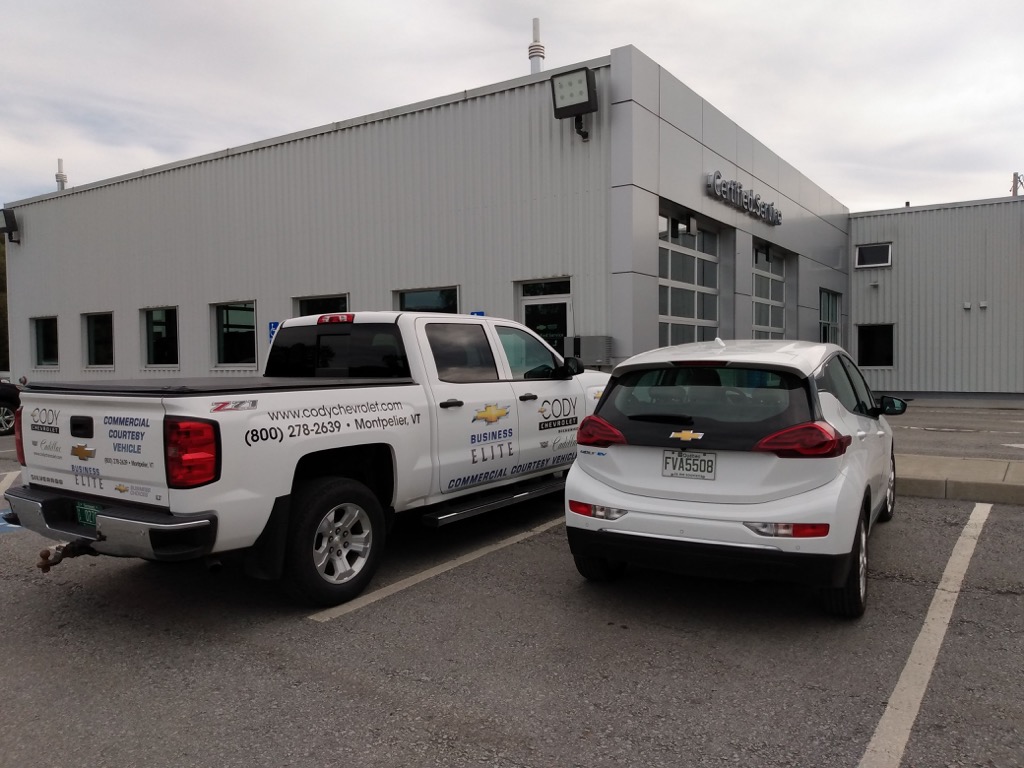
Fortunately the charger’s cord was long enough to stretch to the next parking spot, and I was able to plug myself in. This was a free charger, not networked in any way, so had no way of communicating with my phone to alert me when the charge was done. There were also no instructions whatsoever on the charger, so I to had make my best guess how to use it:
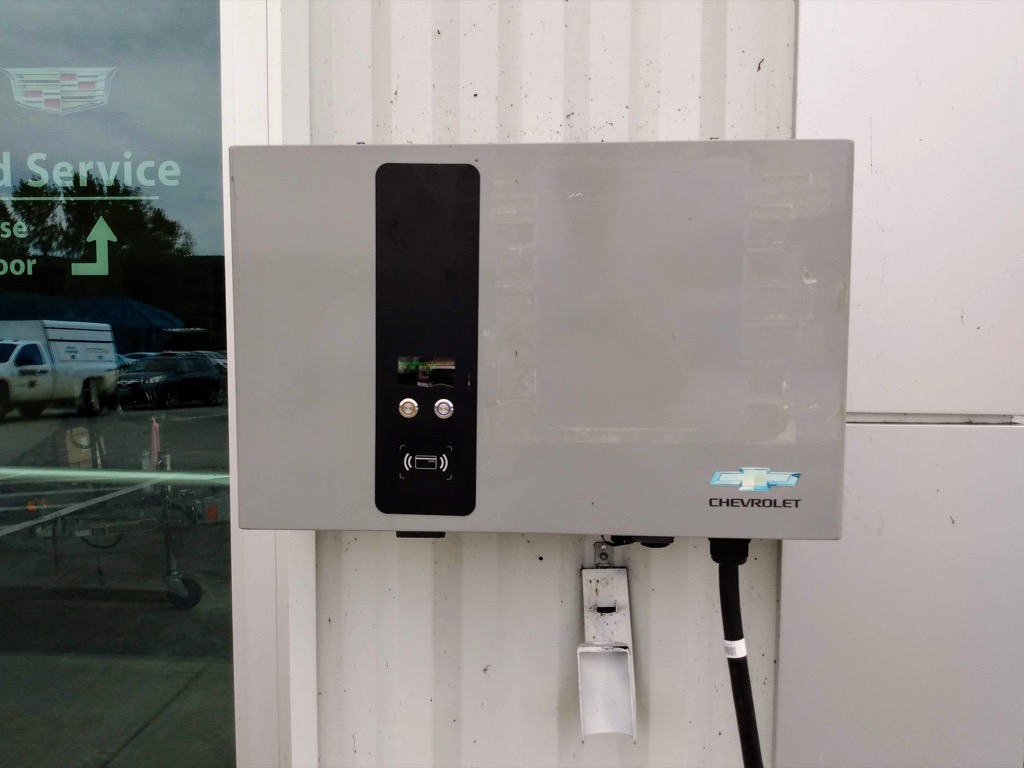
Fortunately my best guess worked, and when I pressed the green(ish) button, it started up in a cacophony that sounded like it was preparing for a Moon launch. The LCD on the charger told me that my Bolt was 45% charged, and that it would be at 80% after 50 minutes. So I left it charging, walked up the road to the 101-year-old Wayside Restaurant for some blueberry pancakes while I was waiting.
When I returned an hour later the charge cycle was just completed, having pumped 21.3 kWh into the car, and taking it to 77% charge.
I got back on I-89 south and headed toward Brattleboro, Vermont, where I planned to eat supper.
Sunday, 5:55 p.m.
As Brattleboro, VT had the final high-speed DC charger before I left the EV-friendly Vermont for the slim charger pickings of New Hampshire, I decided to top up again over supper.
In the High Grove Parking Lot downtown I found an EVgo charger with the right CCS/SAE connector for the Bolt. I ran into a problem getting the EVgo app working on my phone, however, and traced the issue to the fact that the Public Mobile data package for my cell phone that I’d purchased for U.S. roaming had been completely drained of its 250 MB of data by a rogue podcast app. Not only couldn’t I use data on the phone, but I couldn’t renew the data plan without the data plan. I thought I was stuck until I found an open Xfinity wifi with a 24 hour free trial. That was enough to get me sorted with the EVgo app, and once it was installed and I’d entered a credit card for billing, the charger started up.
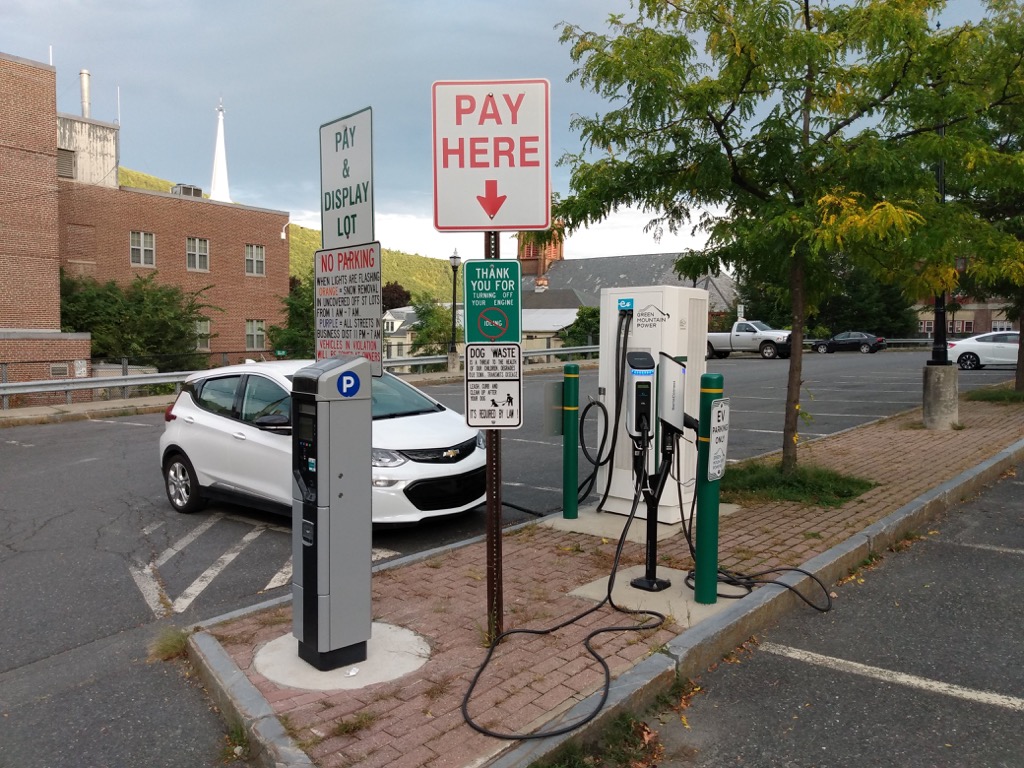
I walked downtown for supper at The Works Café. After supper I walked back up the hill and just as I entered the parking lot I got a text telling me the charge was finished. At 35 cents a minute, this was the most expensive charge of the trip: I paid $16.85 US for 27.75 kWh of electricity delivered in 45 minutes.
Sunday, 7:24 p.m.
I made a quick stop in Keene, NH at the Chevy dealer there to see if perchance they had an unreported DC charger, but they ended up having no charger at all. The KIA dealer next door did have a couple of free AeroVironment chargers; I added them to the PlugShare map and drove on.
Sunday, 8:09 p.m.
I landed at the Jack Daniels Motor Inn in Peterborough, NH–my home for the week–with the Bolt reporting it still had 250 km of range left, which was a healthy way to start the week. I was pleasantly surprised to find that a dedicated parking spot for me had been set aside, with orange cones and a sign, along with an extension cord connected to a standard electrical outlet. The Bolt has a charger in its trunk that can be used in situations like this; it’s a slow as molasses way to charge, but it’s something, especially if you leave it overnight. So that’s what I did:

Chevy suggests that charging from a standard 120-volt outlet will provide 4 miles per hour of charge. When I got in the car the next morning it reported 301 km of range after 12 hours of charging, an increase of 51 km (31 miles). That works out to about 2.5 miles of range per hour, so slightly less than advertised.
Monday, 10:00 a.m.
When I arrived at Yankee Publishing on Monday morning–my workplace for the week–I found that the custodian had helpfully set up a place for me to plug into an outlet in the garage:
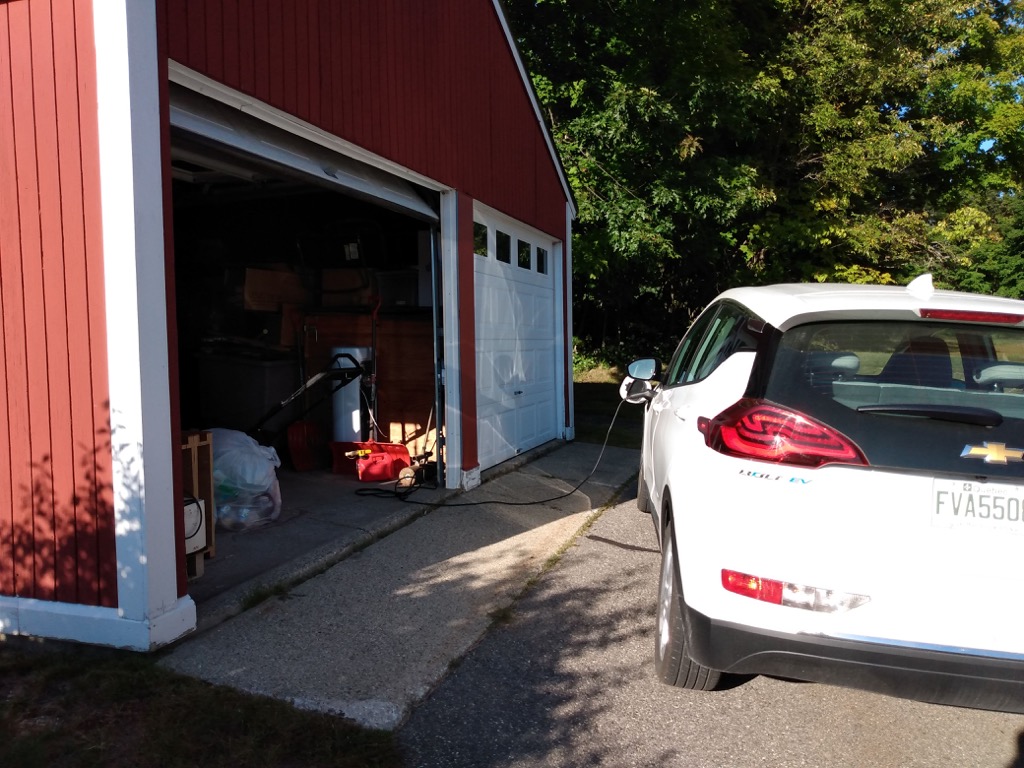
I’ve been back and forth to Yankee every day now–it’s Wednesday as I write–and I’ve been charging during the day there and charging overnight at the Jack Daniels. I was worried that my 12 km commute in each direction would exceed my ability to keep up and that I’d need to dash into Keene or Brattleboro for emergency top-up.
But I pulled out of the Yankee parking lot at the end of the day yesterday with the car reporting 431 km of range, which is, in theory, enough to get me all the way back to Montreal:
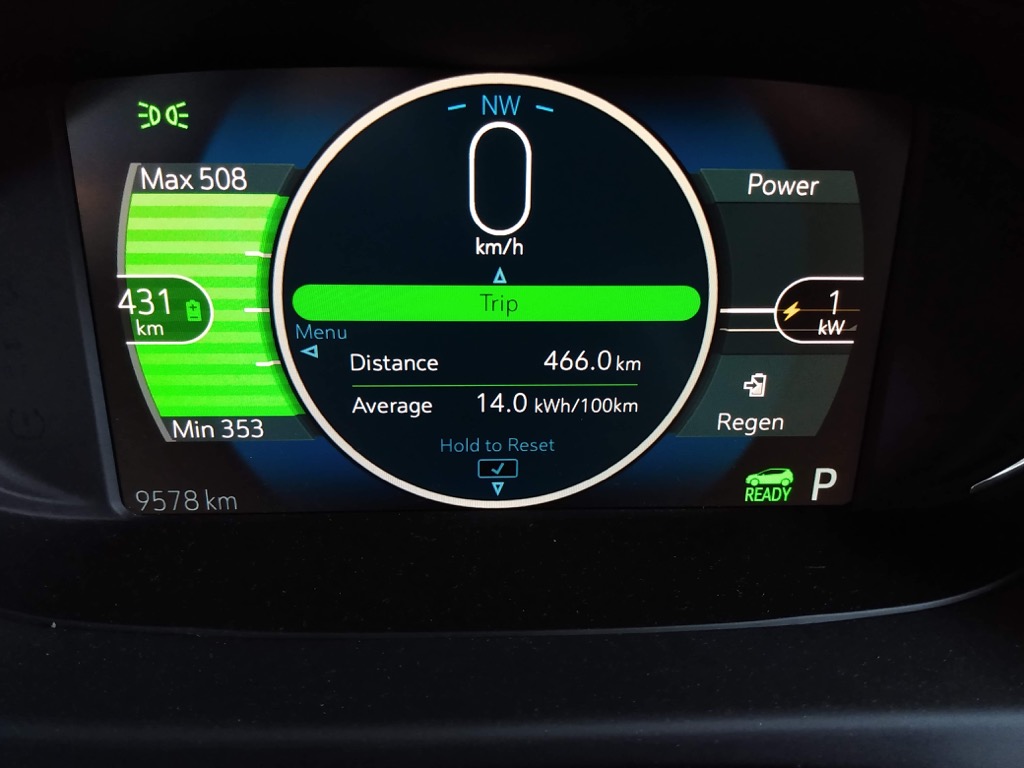
So, in other words, things are working out just fine on the charging front.
Driving the Bolt
The Bolt is the best car I’ve ever driven: it’s easy to drive, fun to drive and, when you need it, has enough acceleration to feel like you’re riding a rocket. Once I got over my range anxiety-anxiety, there ends up being no compromise for driving an EV compared to a gasoline-powered one. Indeed it makes using fossil fueled vehicles seem antediluvian. If nothing else I’ve become convinced that if I ever again buy a car–an open question–it will be an EV.
That said, there are a few weird things about the car, mostly related to technology. In theory the myChevrolet Android app should allow me to do everything from monitor the vehicle’s charging to unlocking the doors. But I became mired in a confusing thicket of accounts and credentials and references to a need for either enabling “Connected Services” and/or “OnStar Services.” Finally I just gave up on this.
Similarly, the in-car wifi access point, alluded to as being included in the rental by this Discount Car Rental blog post, has no Internet access, and seems to require purchase of a service I cannot purchase because I don’t own the vehicle. As I found in Brattleboro when I ran out of data on my phone, EV charging, because it uses different apps from different networks, demands always-on-data, and having in-car wifi would seem like a helpful part of EV rental to enable this.
The Plan for Heading Home
I start back toward home on Friday. I’ve booked a room at the Latchis in Brattleboro for Friday night (conveniently located atop the Latchis Theatre, which is showing the Downton Abbey movie!). I’ll top up the car in Brattleboro for the drive north and leave Saturday night for Burlington. I’ll likely stop again near Montpelier for a charge before staying the night with Valerie and Lars, Sunday I need to have the car back at discount by 2:00 p.m., and I fly out of Montreal for home on Sunday evening.
Where I’ll pick up my bicycle and make a truly zero-carbon last 5 km of my trip along the Confederation Trail.

If you read my tale of riding my bicycle to the airport you may have made note of the apparent absurdity of doing so only to get on an airplane, which is not at all a low-carbon-emitting kind of thing to do.
But there was method to my madness.
Two or three times a year I travel from my home in Charlottetown to Dublin, New Hampshire to spend a week working with colleagues at Yankee Publishing. I’ve used a variety of ways of making this trip over the years, but most often I fly from Charlottetown to Halifax or Montreal, and then from there to Boston, rent a car, and drive the 90 minutes northwest to southern New Hampshire.
Earlier this summer, when I was making plans to again take this trip this September, I was talking to a friend about Green Party of Canada leader Elizabeth May; she, whenever possible, takes the train rather than flying (not an easy thing to do when running a national political operation).
That got me thinking that maybe I should take the train this time. There are no rail connections from Atlantic Canada into the northeastern U.S., but there is an overnight train from Moncton to Montreal, and a connecting bus from Charlottetown to Moncton.
When I discovered that I could rent a battery-electric vehicle in Montreal and drive from there to New Hampshire, and spend less doing so than the cost of renting a gasoline-powered car in Boston for the same period, I was sold.
I booked a bus-train journey from Charlottetown to Montreal, and reserved a Chevy Bolt from Montreal for the week.

The cost for the return fare, Maritime Bus from Charlottetown to Moncton and VIA Rail from Moncton to Montreal, was $1,148 and the journey would start on Friday at 1:00 p.m. and I’d arrive Montreal on Saturday at 10:00 a.m., returning the following Sunday, leaving Montreal at 7:00 p.m. and arriving Charlottetown on Monday 5:05 p.m., for a total travel time of 43 hours.
I decided to check my work.
I was going to be using this trip as an example of how long-distance travel without flying is possible and I wanted to make sure that the carbon emissions numbers added up. So I emailed the VIA Rail press office a query:
I’m a blogger who’s booked a bus-train combination from Charlottetown to Montreal in September, in part to be able to write about the difference in carbon footprint from taking the train vs. flying.
You have a helpful carbon calculator on your website, but it doesn’t include The Ocean, and so I’m wondering if you can fill in this gap for me directly: I have booked the Maritime Bus from Charlottetown to Moncton return, and room-for-1 on The Ocean return.
A week later VIA Rail emailed me the answer:
The total greenhouse gas emissions for a one-way trip on the Ocean between Moncton to Montreal is: 1,053.71 Kg of CO2e.
That seemed like an awful lot of carbon emitting for what I was holding out hope for as low-carbon travel: 2 tonnes of CO2e is an eighth of what our house emits in an entire year according to our EnerGuide assessment.
I compared the figure to the purported carbon emissions from flying the same Moncton to Montreal route, and they ranged from 90 kg to 130 kg for the one-way trip. About ten times lower than taking the train.
Surely VIA Rail’s numbers must be off, I reasoned. Or maybe it was the fact that I’d booked a bedroom rather than a coach seat. So I checked, with a follow-up to VIA:
As a supplementary, then, can you tell me what the CO2e figure would be if, rather than traveling in a bedroom I was to travel in a regular economy seat?
VIA’s reply was:
Whether you are travelling in a bedroom or in a regular economy seat, the greenhouse gas emissions are the same.
Having reached the edge of my ability to parse this, I looked for help from energy and transportation experts, an uncommon number of whom appeared to simply assume that VIA’s numbers couldn’t possibly be true, and suggest that I take the train regardless.
The most valuable advice I received came from Ryan M. Katz-Rosene from the University of Ottawa, who I found via a CBC story about the carbon emissions from air travel.
Ryan wasn’t surprised by VIA’s number, crediting the high carbon emissions to a combination of a long, meandering route, low occupancy (due, in part, to the low passenger-to-car ratio in sleeping cars), and the use of inefficient diesel locomotives. He did question that VIA uses the same emissions-per-passenger figure for both coach and sleeper seats; I wondered about this as well.
Ultimately he was forced to conclude:
When all is said and done, it does appear to be the case that in this particular instance flying is less carbon intensive than taking the train.
He added an important caveat, however:
VIA has tremendous potential for improvement. So, in a way, you could still justify taking the train in principle on the premise that you want to financially support a Crown corporation which can really use those funds to dramatically improve its service (and thus increase occupancies, and reduce emissions)… but my take is that, given the current situation, best response (if you absolutely must take one of those two options) is to fly and then write a letter to your MP pointing out how unacceptable the whole situation is!
Much of the political conversation about passenger rail in Canada concerns high speed rail. For long distance routes like Halifax to Montreal speed is a secondary concern, as the distance means that it’s always going to be a long run; this means that we can turn ourselves to high efficiency rail, both the efficiency of the rolling stock and of the logistics of actually taking the train.
The notion that a Prince Edward Islander might choose to take the train to Montreal, for example, seems to occupy roughly 0% of VIA Rail’s marketing efforts. There is no long-term parking at the Sackville VIA Rail station (the closest one to PEI). Bus connections to and from the Moncton VIA station on Maritime Bus aren’t guaranteed: if the train is late and the bus leaves, you’re out of luck. It is by no means part of an integrated transportation network for Islanders. I imagine that’s part of the “tremendous potential for improvement” that Ryan references.
Ryan finished his email with one final comment:
Or you could take the bus.
And I seriously considered that: my emissions would be considerably lower (about 25 to 50 kg of CO2e), and the cost–about $200 return–would have been half the cost of flying and a fifth the cost of the train.
But ultimately I decided that sitting on a bus for 34 hours (15 hours there, 19 hours back) was a bridge too far for me.
And while that reflects a distressing lack of fortitude on my part, it also points out that for low-carbon travel to become as popular is it needs to be, it will help if it isn’t also perceived a dreadful experience.
Taking the train to Montreal, as I found in 2017, is thoroughly enjoyable; taking a long distance bus ride is, by almost any measure, an exhausting and uncomfortable way to travel, and few people would choose it if there’s any other reasonable alternative.
So I flew.

The air trip took 90 minutes. I cycled to Charlottetown Airport. I took hybrid buses and the Metro from Trudeau Airport to my brother’s house, and then, later in the day, we used a Toyota Prius car-share to travel to the Discount Car rental depot to pick up my Chevy Bolt for the drive to New Hampshire.
My next step is to do what Ryan suggested: write my MP–and, indeed, all the federal candidates in Charlottetown–asking them their plans for high efficiency long-distance rail travel from Prince Edward Island.
I woke up at 3:45 a.m. on Saturday morning. I showered, got dressed, made myself a coffee and some granola with yogurt.
After my quick breakfast, I took my bicycle trailer out of the front room and set it on the sidewalk, and filled its bucket with my suitcase and backpack. I wheeled my bicycle out of the front hall and hooked it up to the trailer, using the light on my phone to help me guide the cotter pin through the hole that holds it in place.
And then I rode my bicycle to the airport.
I’d only hatched the plan the night before.
My habit for more than 20 years when leaving on an early morning flight from Charlottetown has been to call Coop Taxi and order up a cab for an hour before departure; on Friday night I was about to do the same thing when it occurred to me that, given that I’m attempting to make this trip to New Hampshire that I’m now in the midst of, as low-carbon-emitting as possible, I should consider the possibility of taking my bicycle instead of a taxi.
This was an inane idea.
My flight was for 6:25 a.m.
The sun wasn’t going to rise until 6:50 a.m., by which time I’d be in the air for 25 minutes already.
The weather forecast called for a temperature of 7ºC.
Charlottetown Airport is 5 km from my house and I’d only ever taken an electric-assist bicycle there before; while friends of mine regularly head out for 100 km jaunts on a Sunday afternoon, 5 km is a long distance ride for me.
Clearly this wasn’t going to work. I gave up on the idea.
Then fate intervened: I turned my attention to writing an email to my friend Thelma, and I added, at the end:
I’m off to New Hampshire in the morning via the early flight to Montreal. I’m currently trying to decide whether my climate commitments extend to riding my bicycle to the airport at 5:00 a.m. in 7°C weather.
By writing this I unwittingly caused the idea to take on a new life. And to come up with real reasons that this wasn’t possible (“Well, Greta Thunberg, I couldn’t really ride my bicycle to the airport because my hands would get cold…”).
The die was cast.
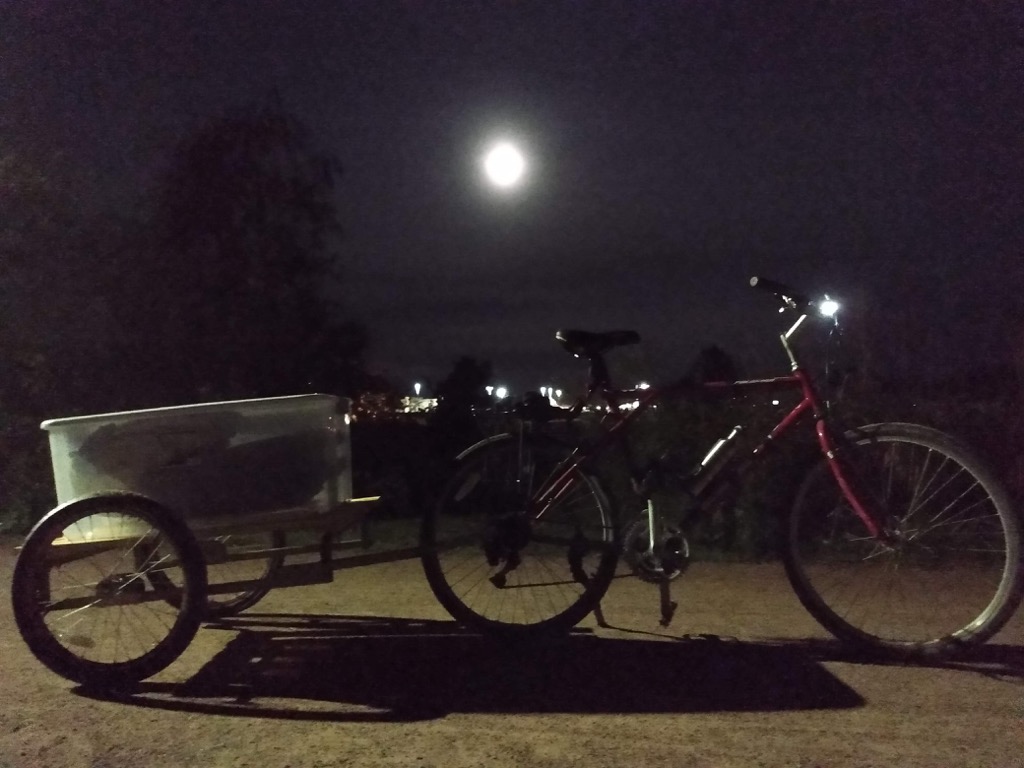
Google Maps told me that it would take me 27 minutes to ride to the airport. It took me 44 minutes: I left at 4:45 a.m. and arrived at 5:28 a.m. The extra time was due a combination of the aforementioned darkness (the Confederation Trail is well-lit until you get to Mount Edward Road, then it’s shrouded in inky darkness), hurricane-induced trees across the trail between the bypass and the airport, a couple of water breaks, my pulling a trailer, and my relative lack of fitness (that said, this trip wouldn’t have been possible without the uptick in fitness from a summer of cycling almost every day).
The going was mostly flat or a gentle upslope, with the exception of the stretch of Sherwood Road from the trail up to the airport which defeated me and required that I hop off and push (I reverted to riding when I realized that although riding was hard, pushing bike and trailer was harder).

When I pulled into the employee parking like just before 5:30 a.m. my airplane was ready and waiting.
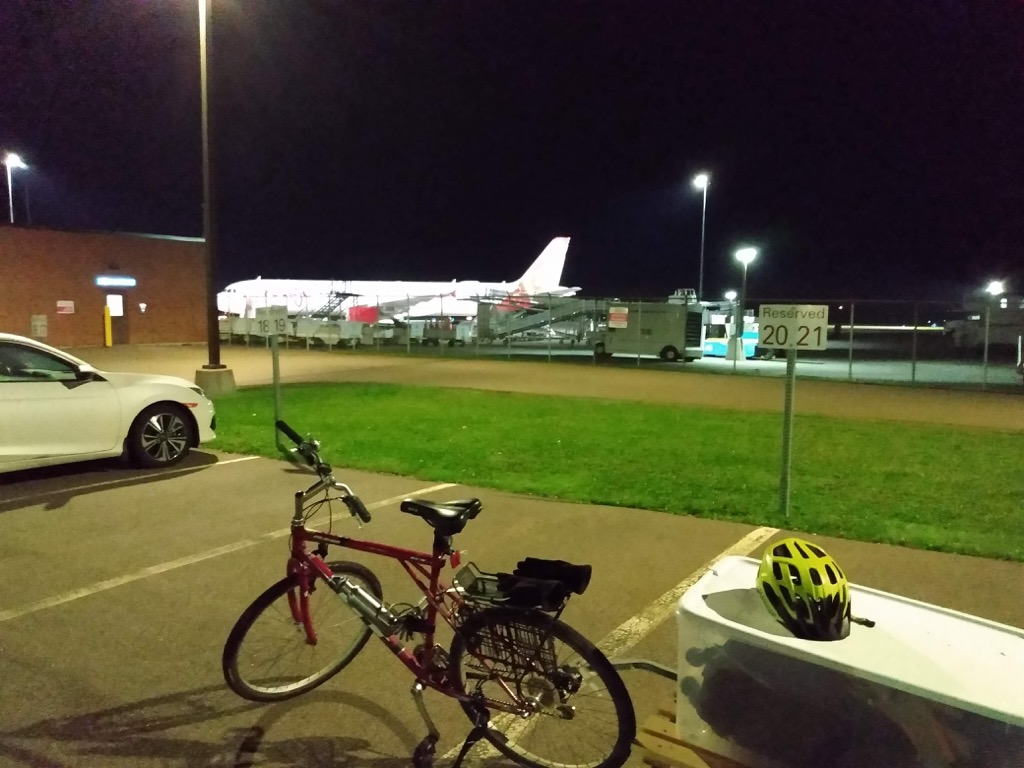
The only bicycle rack at the airport is by the employee entrance on the right side near the departure doors; I’d checked earlier to ensure that it was okay for me to park there and was assured that there would be no problem. So I unloaded my gear and locked my trailer to my bike:
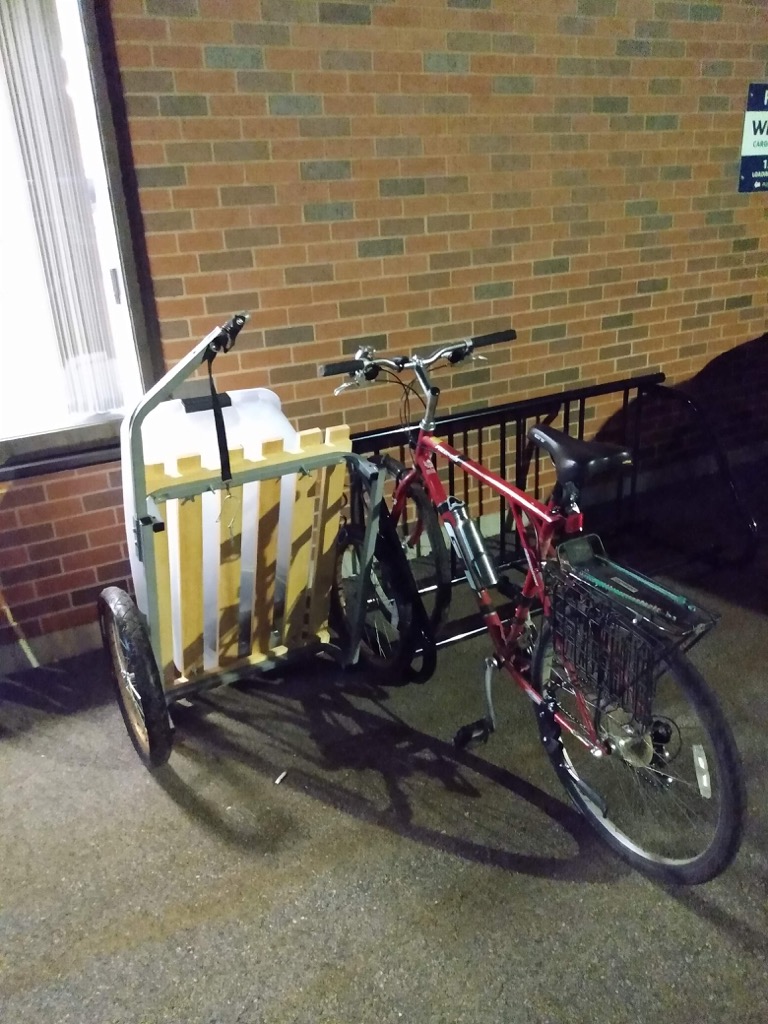
Given that the employee break room is right next door, and that it’s an airport, I suspect this might be the most secure bicycle parking in Charlottetown.
Walking into the airport, the combination of the early hour and the strenuous opening exercises combined to place me in a rather pleasant stress-free haze that made the transit through security and the wait for boarding as anxiety-free as I’ve ever experienced.
I slept most of the flight to Montreal.
I’m away for a week, returning from Montreal next Sunday. My flight lands at 11:25 p.m., so my ride home will be equally inky. I just hope it’s not raining.
Remember my tale of How to Live in Detroit Without Being a Jackass?
Well, I ordered it on September 3, it arrived 7 days later at The Bookmark, and I picked it up today.
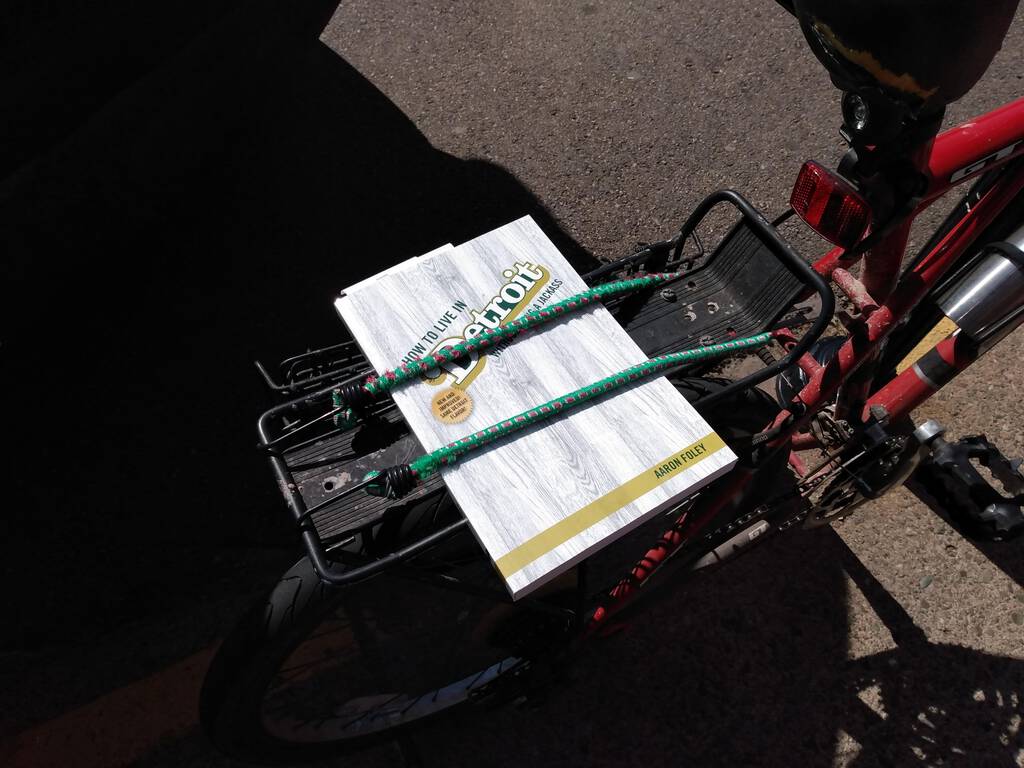
Local independent bookstore FTW.
As you all know, I love that it’s possible to load a bicycle on the front of public transit buses in Charlottetown, and, since I first wrote about this in 2013, I’ve tried hard to spread the word to others.
More often than not the reaction I get, even from frequent cyclists, is “I can take my bicycle on the bus!?”
Fortunately, I now have an additional superpower, via my membership on the Mayor’s Task Force on Active Transportation, and I’m happy to report that one of my fellow members is spearheading an effort to organize an information session on bicycle-carrying-buses.
This event will happen in the parking lot of the Charlottetown Farmers’ Market on September 28, 2019 from 10:00 a.m (details are here on the City of Charlottetown website).
This is a collaborative effort of the Task Force, city officials, T3 Transit and the Market.
A couple of years ago, T3 Transit made this great how-to video that explains the process of getting your bicycle into the rack; my hope is that people will use the opportunity on September 28 to ride their bicycles to the market (or borrow one of the bikes that will be on-site) and give this a try in the parking lot: there’s nothing like getting a chance to go through the motions for the first time without the pressure of a bus full of people staring at you!
Spread the word!
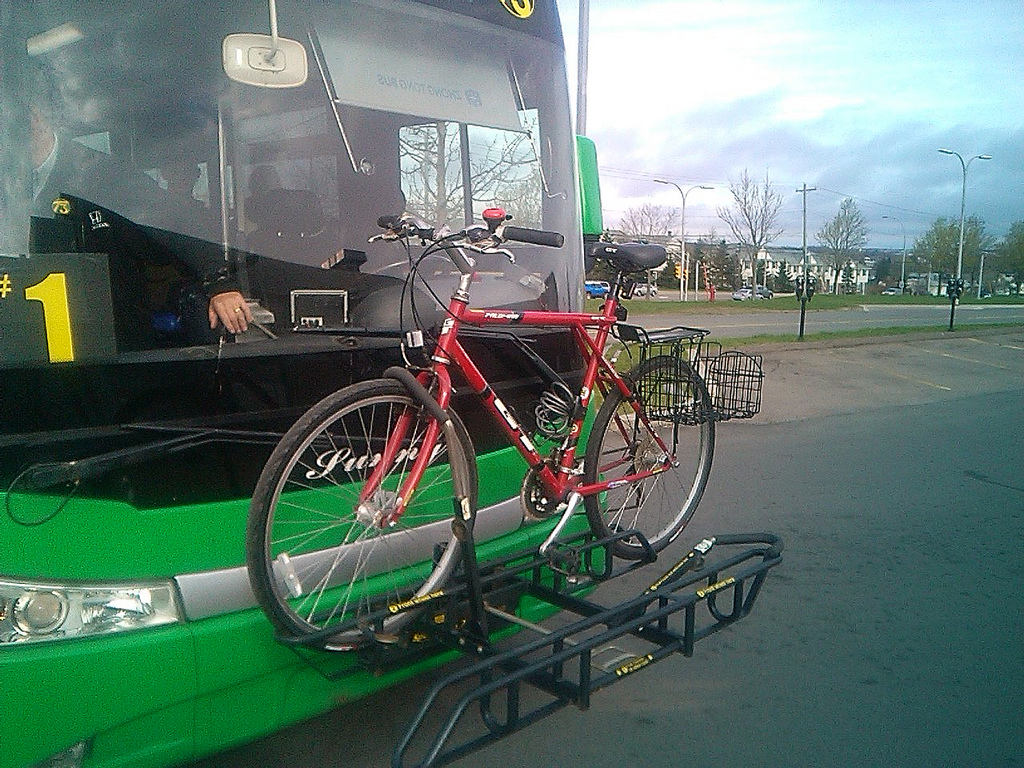
Those of you who have been reading here for a long time may recall that, many years ago during simpler times, I developed a macOS app called PresenceRouter.
PresenceRouter allowed you to echo your geopresence information in Plazes to a variety of other sites (we didn’t call them “social media” back then, just “sites”); by the time of the final release in November 2008 it supported 21 sites in all.
Here’s what it look like to add a new site to the configuration:

In reviewing the apps on my Mac that are 32-bit ( > About This Mac > System Report > Applications), and thus won’t run when macOS Catalina is released later this fall, I noticed PresenceRouter in the list.
In other words, if you upgrade to Catalina, you won’t be able to run PresenceRouter.
Given that Plazes, upon which PresenceRouter depends, shut down 7 years ago itself, this shouldn’t prevent a practical impediment to anyone. But it is the end of an era, and the practical end of a project that taught me a lot about developing Mac apps, about authentication, and about the open web.
More serious for me at this point is that AccountEdge, the bookkeeping app that I rely on to run my business, is still 32-bit-only, and won’t be updated in time for the Catalina release. So I’ll be stuck in the Mojave until it gets updated.

 I am
I am